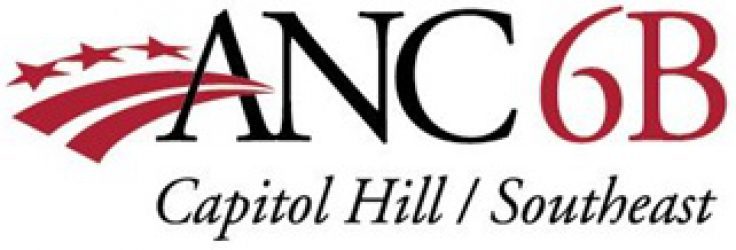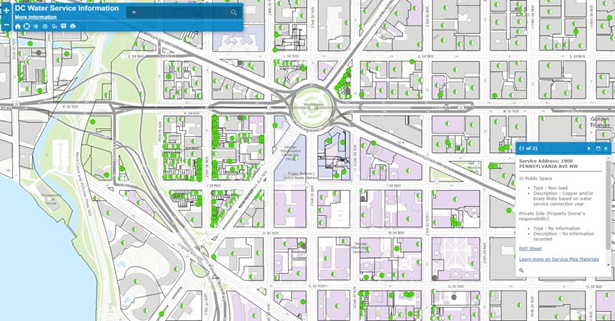- November 2021 Meeting of ANC 6B
- November 2021 ANC 6B Planning and Zoning Committee Meeting
- November 2021 ANC 6B Transportation Committee Meeting
- SPECIAL JOINT MEETING of ANC 6A Transportation and Public Space Committee (TPS) and ANC 6B Transportation Committee (TC) on 17th and 19th Streets Northeast and Southeast (From Benning Road. to Barney Circle)
- January 2022 Meetings of ANC 6B
- January 2022 Planning & Zoning Committee Meeting
- January 2022 Transportation Committee Meeting
- January 2022 ABC Committee Meeting
- January 2022 ANC 6B’s Full Meeting
- January 2022 ANC 6B Executive Committee Meeting
- Special Call Meeting to vote on “As You Are Bar’s” Tavern License Application
- Joint ANC 6A/6B/6C Zoning Committees Meeting with OAG
- As You Are Bar Community Meeting
- Open Streets Capitol Hill 2025
- June 2025 ANC 6B Executive Committee Meeting
- June 2025 Public Safety Committee Meeting
- [LATE BREAKING] Emergency Meeting to Discuss Settlement Agreement for ABRA-131013, 7th Street Love, LLC t/a Acqua Al 2
- June 2025 6B Full ANC Meeting
- June Southeast Library Task Force Meeting
- June Parks & Public Spaces Taskforce Meeting (In Person Only)
- June 2025 6B Planning and Zoning Committee Meeting
- June Transportation Committee Meeting
- June Alcoholic Beverage & Cannabis Committee Meeting
- May 2025 ANC 6B Executive Committee Meeting
- May 2025 6B Full ANC Meeting
- May Southeast Library Task Force Meeting
- May Parks & Public Spaces Taskforce Meeting (In Person Only)
- May 2025 6B Planning and Zoning Committee Meeting
- May Transportation Committee Meeting
- May Alcoholic Beverage & Cannabis Committee Meeting
- RESCHEDULED April 2025 ANC 6B Executive Committee Meeting
- April 2025 6B Public Safety Committee Meeting
- April Parks & Public Spaces Taskforce Meeting (In Person Only)
- April 2025 6B Full Meeting
- April Southeast Library Task Force Meeting
- April Planning & Zoning Committee Meeting
- April Transportation Committee Meeting
- April Alcoholic Beverage & Cannabis Committee Meeting
- March 2025 ANC 6B Executive Committee Meeting
- March Public Safety Committee Meeting – CANCELED
- March Parks & Public Spaces Taskforce Meeting (In Person Only)
- March 2025 6B Planning and Zoning Committee Meeting
- March 2025 Full Meeting
- March 2025 6B Planning and Zoning Committee Meeting
- March 2025 6B Alcoholic Beverage & Cannabis Committee
- Southeast Library Task Force Meeting
- March 2025 6B Transportation Committee Meeting
- February 2025 ANC 6B Executive Committee Meeting
- February 2025 Public Safety Committee Meeting
- Parks and Public Spaces committee (in person only)
- February 2025 Full Meeting of ANC 6B
- February 2025 6B Planning and Zoning Committee Meeting
- February 2025 6B Transportation Committee Meeting
- February 2025 6B Alcoholic Beverage & Cannabis Committee
- January 2025 Southeast Library Taskforce Meeting
- January 2025 ANC 6B Executive Committee Meeting
- January 2025 Parks and Public Spaces Task Force Meeting
- January Public Safety Committee Meeting
- January 2025 Full Meeting of ANC 6B
- *Special Call Meeting to Elect ANC 6B Executive Officers
- January 2025 6B Planning and Zoning Committee Meeting
- January 2025 6B Transportation Committee Meeting
- January 2025 6B Alcoholic Beverage & Cannabis Committee*
- December 2024 ANC 6B Executive Committee Meeting*
- December Southeast Library Taskforce Meeting
- December 2024 Full Meeting of ANC 6B
- December Parks and Public Spaces Taskforce Meeting
- December 2024 6B Transportation Committee Meeting
- December 2024 6B Alcoholic Beverage & Cannabis Committee
- December 2024 6B Planning and Zoning Committee Meeting*
- November Public Safety Committee Meeting
- November 2024 ANC 6B Executive Committee Meeting*
- November Parks and Public Spaces Taskforce Meeting
- November Southeast Library Taskforce Meeting
- November 2024 Full Meeting of ANC 6B
- November 2024 6B Planning and Zoning Committee Meeting
- November 2024 6B Transportation Committee Meeting
- November 2024 6B Alcoholic Beverage & Cannabis Committee*
- October 2024 6B Planning and Zoning Committee Meeting*
- September 2024 ANC 6B Executive Committee Meeting
- September Public Safety Committee Meeting
- September Southeast Library Taskforce Meeting
- POSTPONED: September Parks and Public Spaces Taskforce Meeting
- September 2024 Full Meeting of ANC 6B*
- September 2024 6B Planning and Zoning Committee Meeting
- September 2024 6B Transportation Committee Meeting
- September 2024 6B Alcoholic Beverage & Cannabis Committee
- Special Call Meeting for Cannabis License Applications
- July Public Safety Committee Meeting
- July 2024 Full Meeting of ANC 6B
- July 8th, 2024 Southeast Library Taskforce Meeting
- July Parks and Public Spaces Taskforce Meeting
- July 2024 6B Alcoholic Beverage & Cannabis Committee
- July 2024 6B Planning and Zoning Committee Meeting*
- July 2024 6B Transportation Committee Meeting*
- ANC 6B Special Call Meeting for P&Z Items
- June 2024 ANC 6B Executive Committee Meeting
- June Public Safety Committee Meeting
- June Full Meeting of ANC 6B
- Parks and Public Spaces Taskforce Meeting
- June 2024 6B Planning and Zoning Committee Meeting
- June 2024 6B Transportation Committee Meeting
- June 2024 6B Alcoholic Beverage & Cannabis Committee
- June 3rd, 2024 Southeast Library Taskforce Meeting
- May 2024 ANC 6B Executive Committee Meeting
- May Public Safety Committee Meeting
- May 2024 Full Meeting of ANC 6B
- May 2024 6B Planning and Zoning Committee Meeting
- May 2024 6B Transportation Committee Meeting
- May 2024 6B Alcoholic Beverage & Cannabis Committee
- May 1, 2024 Meeting of the ANC 6B Planning and Zoning Subcommittee on Street and Alley Closings
- April 2024 ANC 6B Executive Committee Meeting
- April 25th, 2024 Southeast Library Taskforce Meeting
- April Public Safety Committee Meeting
- Parks and Public Spaces Taskforce Meeting
- April 2024 Full Meeting of ANC 6B
- April 2024 6B Planning and Zoning Committee Meeting
- April 2024 6B Transportation Committee Meeting
- April 2024 6B Alcoholic Beverage & Cannabis Committee
- April 1, 2024 Meeting of the ANC 6B Planning and Zoning Subcommittee on Street and Alley Closings
- March 2024 ANC 6B Executive Committee Meeting
- March Public Safety Committee Meeting
- March 21st, 2024 Southeast Library Taskforce Meeting
- March 2024 Full Monthly Meeting of ANC 6B
- March 2024 6B Planning and Zoning Committee Meeting
- March 2024 6B Transportation Committee Meeting
- March 2024 6B Alcoholic Beverage & Cannabis Committee
- Parks and Public Spaces Taskforce Meeting
- March 2, 2024 Meeting of the 6B Planning and Zoning Subcommittee on Street and Alley Closings
- February 2024 ANC 6B Executive Committee Meeting
- February Public Safety Committee Meeting
- February 19th, 2024 Southeast Library Taskforce Meeting
- February 2024 Full Meeting of ANC 6B
- February 2024 6B Planning and Zoning Committee Meeting
- February 2024 6B Transportation Committee Meeting
- February 2024 6B Alcoholic Beverage & Cannabis Committee
- January 2024 ANC 6B Executive Committee Meeting
- Parks and Public Spaces Taskforce Meeting
- January 21st, 2024 Southeast Library Taskforce Meeting
- January 13, 2024 Meeting of the 6B Planning and Zoning Subcommittee on Street and Alley Closings
- January 10, 2024 Meeting of the 6B Planning and Zoning Subcommittee on Street and Alley Closings
- January 2024 Full Meeting of ANC 6B
- January 2024 6B Planning and Zoning Committee Meeting
- January 2024 6B Transportation Committee Meeting
- January 2024 6B Alcoholic Beverage & Cannabis Committee
- Emergency Executive Committee Meeting to Discuss ABCA-126724—Seedless LLC, t/a No Kids Allowed
- December 2023 ANC 6B Executive Committee Meeting*
- December 17th, 2023 Southeast Library Taskforce Meeting
- December 2023 Full Meeting of ANC 6B
- December 09, 2023 6B Planning and Zoning Subcommittee on Street and Alley Closings Meeting
- Special Committee on Public Safety Meeting
- December 2023 6B Transportation Committee Meeting
- December 2023 6B Alcoholic Beverage & Cannabis Committee
- December 2023 6B Planning and Zoning Committee Meeting*
- December 3rd, 2023 Southeast Library Taskforce Meeting
- November 2023 ANC 6B Executive Committee Meeting
- November 2023 Full Meeting of ANC 6B
- November 12th, 2023 Southeast Library Taskforce Meeting
- November 2023 6B Planning and Zoning Committee Meeting
- November 2023 6B Transportation Committee Meeting
- November 2023 6B Alcoholic Beverage & Cannabis Committee
- Special Committee on Public Safety Meeting
- October 2023 ANC 6B Executive Committee Meeting
- P&Z Subcommittee on Alley and Street Closings
- October 22nd, 2023 Southeast Library Taskforce Meeting
- October 2023 Full Meeting of ANC 6B
- October Meeting of Parks and Public Spaces Taskforce
- October 2023 6B Planning and Zoning Committee Meeting
- October 2023 6B Transportation Committee Meeting
- October 2023 6B Alcoholic Beverage & Cannabis Committee
- October 2nd, 2023 Southeast Library Taskforce Meeting
- September Special Committee on Public Safety Meeting
- September 2023 ANC 6B Executive Committee Meeting
- September 2023 Full Meeting of ANC 6B
- September 10th, 2023 Southeast Library Taskforce Meeting
- September 2023 6B Planning and Zoning Committee Meeting
- September 2023 6B Transportation Committee Meeting
- September 2023 6B Alcoholic Beverage & Cannabis Committee
- July 30th, 2023 Southeast Library Taskforce Meeting
- P&Z Subcommittee on Alley & Street Closings
- July Meeting of Parks and Public Spaces Taskforce
- July 2023 Meeting of ANC 6B
- July Special Committee on Public Safety Meeting
- July 9th, 2023 Southeast Library Taskforce Meeting
- July 2023 6B Planning and Zoning Committee Meeting
- July 2023 6B Alcohol Beverage Control Committee
- July 2023 6B Transportation Committee Meeting
- June 2023 ANC 6B Executive Committee Meeting
- June Meeting of Parks and Public Spaces Taskforce
- June 2023 Meeting of ANC 6B
- June Meeting of the Special Committee on Public Safety Meeting
- June 2023 6B Planning and Zoning Committee Meeting
- June 2023 6B Transportation Committee Meeting
- June 2023 6B Alcohol Beverage Control Committee
- June 5th, 2023 Southeast Library Taskforce Meeting
- May 2023 ANC 6B Executive Committee Meeting
- Initial Meeting of Parks and Public Spaces Taskforce
- May 22, 2023 Southeast Library Taskforce Meeting
- Meeting of the Special Committee on Public Safety Meeting
- May 2023 Meeting of ANC 6B
- May 7, 2023 Southeast Library Taskforce Meeting
- May 2023 Planning and Zoning Committee Meeting
- May 2023 Transportation Committee Meeting
- May 2023 Alcohol Beverage Control Committee
- April 2023 ANC 6B Executive Committee Meeting
- April 23, 2023: Southeast Library Taskforce Meeting
- April 2023 Meeting of ANC 6B
- April 10, 2023: Southeast Library Taskforce Meeting
- April 2023 Planning and Zoning Committee Meeting
- April 2023 Transportation Committee Meeting
- April 2023 Alcohol Beverage Control Committee
- March 2023 ANC 6B Executive Committee Meeting
- March 26, 2023: Southeast Library Taskforce Meeting
- Special Committee on Public Safety Meeting
- March 2023 Meeting of ANC 6B
- March 2023 Southeast Library Taskforce Meeting
- March 2023 Alcoholic Beverage Control Committee
- March 2023 Transportation Committee Meeting
- March 2023 Planning and Zoning Committee Meeting
- Special Committee on Public Safety Meeting
- Special Call Meeting of ANC 6B Transportation Committee – Electric Vehicles
- February 2023 ANC 6B Executive Committee Meeting
- Southeast Library Task Force Meeting
- *Special Call Meeting to Elect ANC 6B Committees, Task Forces & Working Groups
- *February 2023 Meeting of ANC 6B
- February 2023 Alcohol Beverage Control Committee Meeting
- February 2023 Transportation Committee Meeting
- February 2023 Planning and Zoning Committee Meeting
2020 Meetings
2021 Meetings
November 2021 Meeting
2022 Meetings
January 2022 Meeting
2025 Meetings
June 2025 Meeting
May 2025 Meeting
April 2025 Meeting
March 2025 Meeting
February 2025 Meeting
January 2025 Meeting
2024 Meetings
December 2024 Meeting
November 2024 Meeting
September 2024 Meeting
July 2024 Meeting
June 2024 Meeting
May 2024 Meeting
April 2024 Meeting
March 2024 Meeting
February 2024 Meeting
January 2024 Meeting
2023 Meetings
December 2023 Meeting
November 2023 Meeting
October 2023 Meeting
September 2023 Meeting
July 2023 Meeting
June 2023 Meeting
May 2023 Meeting
April 2023 Meeting
March 2023 Meeting
February 2023 Meeting
2022 Meetings
DC Water – Lead Free DC
Do you have Lead pipes? Let us help you find out
Do you have Lead pipes? Let us help you find out | DCWater.com
ANC 6B Lead Free DC Presentation
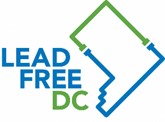 Protecting drinking water from lead sources is the shared responsibility of DC Water and the property owner. DC Water strongly encourages residents to identify and replace any lead pipes or plumbing materials serving their home, especially lead service lines. Lead service lines were predominately installed prior to the mid-1950s in the District of Columbia, but there are records of lead service lines being installed as late as 1977. You can use our service line map to see if your property has, or might have, a lead service line.
Protecting drinking water from lead sources is the shared responsibility of DC Water and the property owner. DC Water strongly encourages residents to identify and replace any lead pipes or plumbing materials serving their home, especially lead service lines. Lead service lines were predominately installed prior to the mid-1950s in the District of Columbia, but there are records of lead service lines being installed as late as 1977. You can use our service line map to see if your property has, or might have, a lead service line.
Click Our Map to Check for Lead Service Lines on Your Property
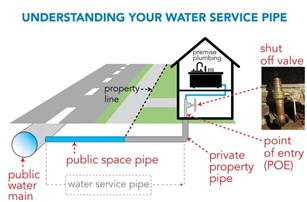 The District/DC Water has collected pipe material data for service lines based on permit records, water main tap records, meter records, and maintenance, repair and replacement work. However, much of the service line pipe material data is based on the historic records and not confirmed.
The District/DC Water has collected pipe material data for service lines based on permit records, water main tap records, meter records, and maintenance, repair and replacement work. However, much of the service line pipe material data is based on the historic records and not confirmed.
Inspect Your Service Line to Identify Lead
The water service line coming into many homes can help identify or confirm the pipe material. Click here to learn more about Identifying Lead or use this guide to assist with pipe material identification.
The Most Common Pipe Materials
Service pipes can consist of many different materials. Typical service pipe materials include lead, galvanized steel, plastic, brass and copper as shown below:
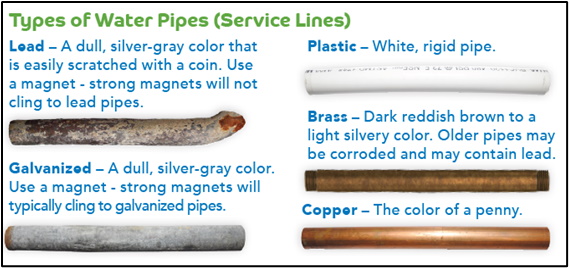
Identify your Pipe Material
You can identify your pipe material by checking your household water service connection inside the home, typically located in the basement. Our Guide to Identifying Service Line Material and the videos below can help you to determine your service line material and/or plumbing material. You can also contact a licensed plumber to inspect your pipes, but they will likely do the same assessment as described in the guide and videos.
How To Locate Your DC Water Service Line Coming Into Your Home
Lead Pipe Scratch Test
If you have a lead service pipe, we encourage you to take advantage of our lead service pipe replacement program. Click here to learn more.
Help us update our records
If you are able to determine your type of service line material, please send a photograph and your identification of the material to leadtest@dcwater.com so we can update our records. If you are unsure, note that in the email and we will conduct an evaluation and respond.
When the water main was originally installed, the pipe material connecting to the main was the same as the material entering your property. However, service line repairs or property renovations may have changed a portion of the original continuous service line. If you have already replaced your lead service line, please send us a copy of the records by mail or email so we can update our records for your property. In addition, send us a picture of the service line entering your home. This will help confirm the type of pipe material.
Mailing Address
District of Columbia Water and Sewer Authority
Lead Pipe Replacement Program
301 Bryant St NW
Washington, DC 20001
Additional Household Sources of Lead in Drinking Water
While the most common sources of lead in drinking water are lead pipes, lead welding solder, household plumbing fixtures and pipe fittings made prior to 1986, and galvanized steel may also contain lead.
Lead Solder
Solder connects pipes in household plumbing. Until 1987, lead solder was used in household plumbing. If your house was built before 1987, your plumbing may have lead solder.
Brass Faucets, Valves or Fittings
Almost all faucets, valves and fittings have brass components, which may contain lead. Until 2014, brass faucets and fittings sold in the United States and labeled “lead-free” could contain up to eight percent lead. Brass service lines may also contain lead. Effective January 2014, the Reduction of Lead in Drinking Water Act specifies that these materials may not contain more than 0.25 percent lead.
Galvanized Iron Pipes
Household galvanized pipes are old, corroded pipes that were installed in many homes before the 1960s. These pipes can release lead in water if the property has, or previously had, a lead service pipe. Galvanized pipes are made with a protective layer of zinc. However, the zinc layer erodes over time and results in corrosion. When lead is released from a lead service pipe and passes through galvanized plumbing, lead can accumulate on the inside, corroded walls of this plumbing. Lead release from galvanized pipes can vary from home to home and can continue to occur even after a lead service pipe is replaced.
